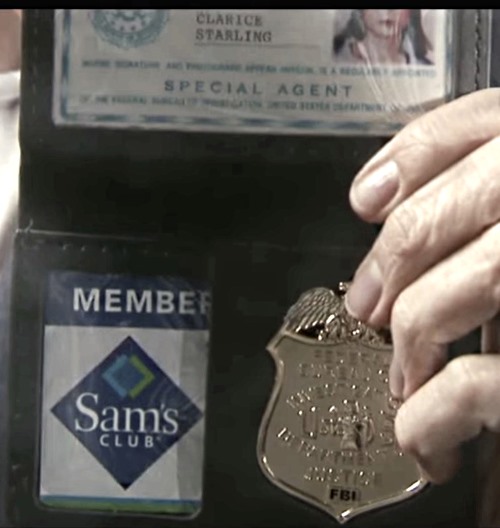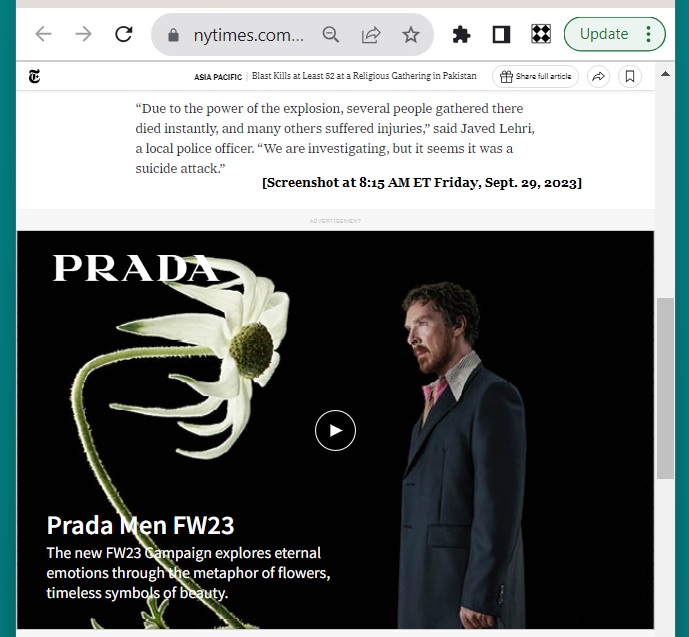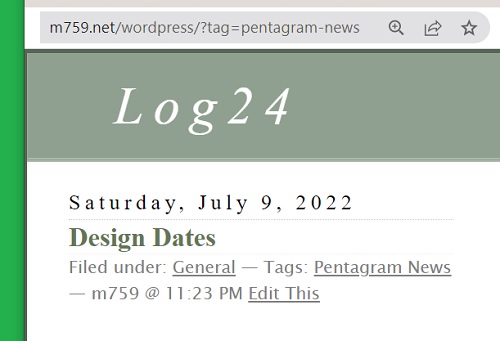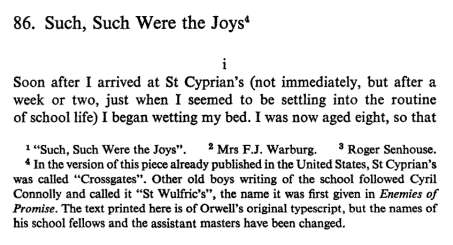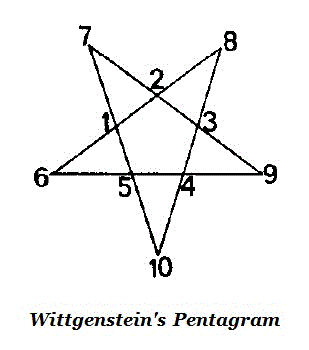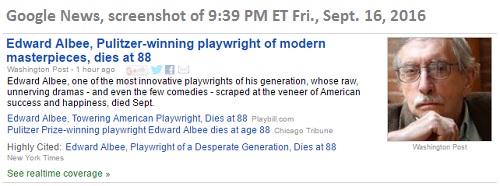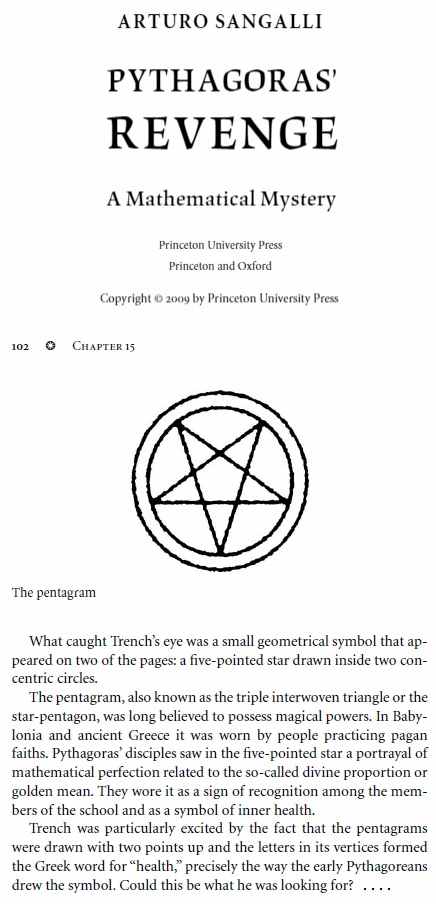"Should we arbitrate life and death
at a round table or a square one?"
Friday, January 5, 2024
The Pentagram Papers
Friday, January 22, 2021
Pentagons, Pentagrams, PG(3,2)

See the current Wikipedia article on Hoffman. No death date is yet given.
A related article —
See as well Hoffman-Singleton in this journal.
Wednesday, January 24, 2018
The Pentagram Papers
From a Log24 post of March 4, 2008 —
|
SINGER, ISAAC:
"Sets forth his own aims in writing for children and laments
— An Annotated Listing of Criticism
"She returned the smile, then looked across the room to
— A Swiftly Tilting Planet,
For "the dimension of time," see A Fold in Time, Time Fold,
A Swiftly Tilting Planet is a fantasy for children |
Ibid. —
The pen's point:

John Trever, Albuquerque Journal, 2/29/08
Note the figure on the cover of National Review above —

A related figure from Pentagram Design —
See, more generally, Isaac Singer in this journal.
Friday, January 19, 2018
The Pentagram Papers
Jodie Foster in a Dec. 15, 2017, sketch with Stephen Colbert —
"People invest in and take ownership of brands,
and they wonder why the brand didn’t
ask their permission to change."
— Michael Bierut of Pentagram Design
in a Design Week article of Jan. 17, 2018
Tuesday, January 16, 2018
The Pentagram Papers
Other intersection-points-counting material —
See also Hanks + Cube in this journal —
Friday, September 16, 2016
Wittgenstein’s Pentagram

Related material —
See the story of a British man who reportedly had a doctorate in
physics and mathematics and became a witchcraft enthusiast.
He is said to have died at 85 on September 11, 2016.
As Wittgenstein noted, it is not always clear whether the pentagram
expresses a mathematical or an experiential proposition.
For some mathematical propositions related to the pentagram,
see (for instance) John Baez's slides for his 2008 Glasgow
lecture on the number 5.
For som experiential propositions, see Pentagram in this journal.
Thursday, May 16, 2024
Cube Geometry
From a search in this journal for Kochen —
Related material — Hitchcock in this journal and Mermin Pentagrams on the Web.
Friday, January 19, 2024
Friday, September 29, 2023
Sunday, July 17, 2022
In Memory of “the Gilded Lily”
For the Lily of the title, see The New York Times online tonight
on the life of a socialite-philanthropist who reportedly died on
July 9, 2022.
Related art —

Saturday, July 9, 2022
Design Dates
NY Times news with Google date
of May 30, 2022 (a Monday) —
(Forbes's actual date of death was Sunday, May 22, 2022.
See that date here in light of the May 30 remarks below.)
Also on May 30 —

Sunday, June 26, 2022
Sunday, January 10, 2021
“Glasgow, 1937”
The location in the title is the opening scene of the new version
of "All Creatures Great and Small." The year in the title suggests
a look at (for instance) The Pentagram Papers.
A "support provided by" credit suggests some related images —
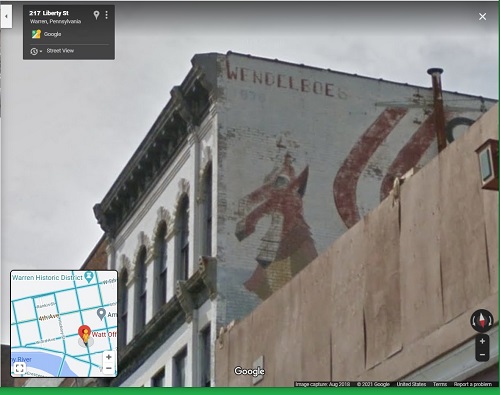
A Scotland-related post: The Blue Path and the Red Path
(Log24, Aug. 24, 2014).
Wendelboe's games included chess sets.
See as well a related purchase from further north on the same block.
Tuesday, December 1, 2020
Sunday, October 18, 2020
Unfolded
See “Unfolded.jpg” in this journal. From that search —
Compare and contrast these figures with images by Wittgenstein in . . .
Related material from last night’s post Modernist Cuts —

Schlick also appears in recent posts tagged Moriarty Variations.
Saturday, August 15, 2020
“Add a Comment” (Instagram, St. Andrew’s Day 2013)
Monday, February 10, 2020
Notes for Doctor Sleep
Or: Plato's Cave.
See also this journal on November 9, 2003 …
A post on Wittgenstein's "counting pattern" —

Thursday, November 8, 2018
Geometry Lesson
From "The Trials of Device" (April 24, 2017) —
See also Wittgenstein in a search for "Ein Kampf " in this journal.
Saturday, February 24, 2018
The Ugly Duck
"What of the night
That lights and dims the stars?
Do you know, Hans Christian,
Now that you see the night?"
— The concluding lines of
"Sonatina to Hans Christian,"
by Wallace Stevens
(in Harmonium (second edition, 1931))
From "Mathmagic Land" (May 22, 2015)
Donald in Mathmagic Land
From "The Trials of Device" (April 24, 2017)
Tuesday, January 16, 2018
An Orison for Ha-Why
Lines from characters played in the film by Tom Hanks and Halle Berry —

— Cloud Atlas , by David Mitchell (2004).
An orison of sorts from a post on Martin Scorsese's
birthday, Sunday, Nov. 18, 2007 —
Displayed on the BlackBerry are parts
of Log24 posts from October 25, 2007,
and October 24, 2007.
Related pattern geometry
From a Log24 search for Angleton + Brotherhood:
A photo of Angleton in a post from 12/9/5 —

From a post of 11/7/8 —
A cryptic note for Dan Brown:
The above dates 11/7/8 and 12/9/5 correspond to the corner-labels
(read clockwise and counter-clockwise) of the two large triangles
in the Finkelstein Talisman —
Above: More symbology for Tom Hanks from
this morning's post The Pentagram Papers.
The above symbology is perhaps better suited to Hanks in his
role as Forrest Gump than in his current role as Ben Bradlee.

For Hanks as Dan Brown's Harvard symbologist
Robert Langdon, see the interpretation 12/5/9, rather
than 12/9/5, of the above triangle/cube-corner label.
Saturday, September 2, 2017
Knight Moves
Ursula K. Le Guin, in Amazing Stories , Sept. 1992, published
"The Rock That Changed Things" (pp. 9-13) and her story from
thirty years earlier, "April in Paris" (Fantastic Stories , Sept. 1962.)
The latter (pp. 14-19) was followed by some brief remarks (p. 19)
comparing the two stories.
For "The Rock," see Le Guin + Rock in this journal.
"April in Paris" is about time travel by means of an alchemist's
pentagram. The following figure from 1962 is in lieu of a pentagram —
See as well a search for 1962 in this journal.
Wednesday, April 26, 2017
A Tale Unfolded
A sketch, adapted tonight from Girl Scouts of Palo Alto —

From the April 14 noon post High Concept —

From the April 14 3 AM post Hudson and Finite Geometry —
From the April 24 evening post The Trials of Device —
Note that Hudson’s 1905 “unfolding” of even and odd puts even on top of
the square array, but my own 2013 unfolding above puts even at its left.
Monday, April 24, 2017
The Trials of Device
"A blank underlies the trials of device"
— Wallace Stevens, "An Ordinary Evening in New Haven" (1950)
A possible meaning for the phrase "the trials of device" —
See also Log24 posts mentioning a particular device, the pentagram .
For instance —
Tuesday, April 4, 2017
Thursday, October 27, 2016
“Space Is the Place!”
Or: Pentagram Meets Counting-Pattern, Continued
Arts & Letters Daily today links to a Chronicle of Higher Education
piece on philosophy with an illustration by the late Paul Laffoley …
This suggests a review of Laffoley's work. In particular —
For a larger view of the above Laffoley pentagram, click here.
Contrast with Wittgenstein's "counting-pattern" above, which
is, in fact, a hyperspace.
Monday, October 17, 2016
Memorial Encounter:
Pentagram Meets Counting-Pattern
Illustrations by Wittgenstein:
See posts from September 16, 2016, the date of death
for Professor Whitman A. Richards.
See also MIT News today —
Monday, October 3, 2016
Hudson’s Inscape
Yesterday evening's post Some Old Philosophy from Rome
(a reference, of course, to a Wallace Stevens poem)
had a link to posts now tagged Wittgenstein's Pentagram.
For a sequel to those posts, see posts with the term Inscape ,
a mathematical concept related to a pentagram-like shape.
The inscape concept is also, as shown by R. W. H. T. Hudson
in 1904, related to the square array of points I use to picture
PG(3,2), the projective 3-space over the 2-element field.
Sunday, October 2, 2016
Some Old Philosophy from Rome
See also Log24 posts from the above reported date of death —
posts now tagged Wittgenstein's Pentagram.
Monday, September 19, 2016
Squaring the Pentagon
The "points" and "lines" of finite geometry are abstract
entities satisfying only whatever incidence requirements
yield non-contradictory and interesting results. In finite
geometry, neither the points nor the lines are required to
lie within any Euclidean (or, for that matter, non-Euclidean)
space.
Models of finite geometries may, however, embed the
points and lines within non -finite geometries in order
to aid visualization.
For instance, the 15 points and 35 lines of PG(3,2) may
be represented by subsets of a 4×4 array of dots, or squares,
located in the Euclidean plane. These "lines" are usually finite
subsets of dots or squares and not* lines of the Euclidean plane.
Example — See "4×4" in this journal.
Some impose on configurations from finite geometry
the rather artificial requirement that both points and lines
must be representable as those of a Euclidean plane.
Example: A Cremona-Richmond pentagon —
A square version of these 15 "points" —

A 1905 square version of these 15 "points"
with digits instead of letters —
See Parametrizing the 4×4 Array
(Log24 post of Sept. 13, 2016).
Update of 8 AM ET Sunday, Sept. 25, 2016 —
For more illustrations, do a Google image search
on "the 2-subsets of a 6-set." (See one such search.)
* But in some models are subsets of the grid lines
that separate squares within an array.
Friday, September 16, 2016
Tuesday, April 5, 2016
Spring Play
The spring play this March at Princeton's McCarter Theatre Center
was Agatha Christie's "The Mousetrap."
In related news —
See as well, in this journal, a post from the date pictured above,
that of the Disneyland Diamond Celebration on May 22, 2015 —
Friday, May 22, 2015
You Can’t Make This Stuff Up
Synchronicity check on the date of the above Salon story:
Two posts from Log24 on Jan. 5, 2014 —
|
Wednesday, October 1, 2014
Good Question
Tuesday, September 30, 2014
Pythagorean Selfie
“Rarely is a TV show as brilliant and as terrible as Selfie .”
— Kevin Fallon on a new ABC TV show that starts tonight at 8 PM ET
A recent selfie from Josefine Lyche’s Instagram page:

For some remarks related to Lyche’s pentagram, see
Lyche + Mathmagic* and also yesterday’s Michaelmas Mystery.
In today’s previous post, the late Harvey Cohn posed a question that
he said might have been asked by Pythagoras:
“It is an elementary observation that an integral right triangle
has an even area. Suppose the hypotenuse is prime.
Q. How do we determine from the prime value of the hypotenuse
when the area is divisible by 4, 8, 16, or any higher power of 2?
A. We use class fields constructed by means of transcendental
functions, of course!”
— From the preface to Introduction to the Construction of Class Fields ,
by Harvey Cohn (Cambridge University Press, 1985)
Illustration:

For a related song, see Prime Suspect (Dec. 13, 2007).
Footnote of 12:14 AM Oct. 1, 2014 —
* That search yields a link to…
This Lyche webpage’s pentagram indicates an interest in Disney rather than
in Satanism. Other Lyche webpages have been less reassuring.
Related material — Posts tagged Elegantly Packaged.
Monday, September 29, 2014
Michaelmas Mystery
Some related material in this journal: “Peter J. Cameron” + Magic.
Monday, September 15, 2014
A Seventh Seal
This post was suggested by the two previous posts, Sermon and Structure.

Vide below the final paragraph— in Chapter 7— of Cameron’s Parallelisms ,
as well as Baudelaire in the post Correspondences :
Comme de longs échos qui de loin se confondent
Dans une ténébreuse et profonde unité….
— Baudelaire, “Correspondances “

A related image search (click to enlarge):
Sunday, September 14, 2014
Sermon
Epigraphs from Parallelisms of Complete Designs
by Peter J. Cameron (Cambridge University Press, 1976)
Introduction
Through the unknown, remembered gate
When the last of earth left to discover
Is that which was the beginning
(T. S. Eliot: Little Gidding)
I The existence theorem
Here the impossible union
Of spheres of existence is actual
(T. S. Eliot: The Dry Salvages)
II The parallelogram property
A condition of complete simplicity
(Costing not less than everything)
(T. S. Eliot: Little Gidding)
III Steiner points and Veblen points
You say I am repeating
Something I have said before. I shall say it again.
Shall I say it again?
(T. S. Eliot: East Coker)
IV Edge-colourings of complete graphs
And hollyhocks that aim too high
Red into grey and tumble down
(T. S. Eliot: East Coker)
V Biplanes and metric regularity
Two and two, necessarye conjunction,
Holding eche other by the hand or the arm
Whiche betokeneth concorde.
(T. S. Eliot: East Coker)
VI Automorphism groups
At the still point of the turning world. Neither flesh nor fleshless;
Neither from nor towards; at the still point, there the dance is,
But neither arrest nor movement.
(T. S. Eliot: Burnt Norton)
VII Resolutions and partition systems
… fiddle with pentagrams
Or barbituric acids, or dissect
The recurrent image into pre-conscious terrors .. .
(T. S. Eliot: The Dry Salvages)
Wednesday, May 14, 2014
Death in Mathmagic Land
"It was our old friend Pythagoras who discovered
that the pentagram was full of mathematics."
— Narrator, "Donald in Mathmagic Land," Disney, 1959
… and it was Peter J. Cameron who discovered that
mathematics was full of pentagrams.
From Log24 on May 3: Gray Space —
Robert J. Stewart (left) and a pentagram photo posted May 2
by Oslo artist Josefine Lyche. See also Lyche in this journal.
From Log24 on May 13: An Artist's Memorial —
The death mentioned in the above May 13 post occurred on
May 12, the date of a scheduled Black Mass at Harvard.
Related material:


Two -Year College
See last night’s pentagram photo and a post from May 13, 2012.
That post links to a little-known video of a 1972 film.
A speech from the film was used by Oslo artist Josefine Lyche as a
voice-over in her 2011 golden-ratio video (with pentagrams) that she
exhibited along with a large, wall-filling copy of some of my own work.
The speech (see video below) is clearly nonsense.
The patterns* Lyche copied are not.
“Who are you, anyway?”
— Question at 00:41 of 15:00, Rainbow Bridge (Part 5 of 9)
at YouTube, addressed to Baron Bingen as “Mr. Rabbit”
* Patterns exhibited again later, apparently without the Lyche pentagram video.
It turns out, by the way, that Lyche created that video by superimposing
audio from the above “Rainbow Bridge” film onto a section of Disney’s 1959
“Donald in Mathmagic Land” (see 7:17 to 8:57 of the 27:33 Disney video).
Saturday, May 3, 2014
Gray Space
Or: Three Shades of Gray
(Continued from previous Gray Space posts.)
Click the above image for some related mathematics.
Those who prefer “magic” approaches to mathematics*
may consult the works of Robert J. Stewart and his
mentor William G. Gray.
Robert J. Stewart (left) and a pentagram photo posted yesterday evening
by Oslo artist Josefine Lyche. See also Lyche in this journal.
* See the April 2014 banners displayed at the websites
of the American Mathematical Society and of the
Mathematical Association of America, as well as
a mathematician’s remarks linked to here last evening.
Saturday, February 18, 2012
Logo
Pentagram design agency on the new Windows 8 logo—
"… the logo re-imagines the familiar four-color symbol
as a modern geometric shape"—

Sam Moreau, Principal Director of User Experience for Windows,
yesterday—
On Redesigning the Windows Logo—
"To see what is in front of one's nose
needs a constant struggle." —George Orwell
That is the feeling we had when Paula Scher
(from the renowned Pentagram design agency)
showed us her sketches for the new Windows logo.
Related material:
- A Four-Color Theorem,
- The Galois Window, and
-
An illustration from
Finite Geometry of the Square and Cube—

Wednesday, May 16, 2007
Wednesday May 16, 2007
From this morning's New York Times:
"In April, Wiccans won an important victory when the Department of Veterans Affairs settled a lawsuit and agreed to add the Wiccan pentacle to a list of approved religious symbols that it will engrave on veterans' headstones….
Many Wiccans practice some form of magic or witchcraft, which they say is a way of affecting one's destiny, but which many outsiders see as evil. The Wiccan pentacle, a five-pointed star inside a circle, is often confused with symbols of Satanism."







